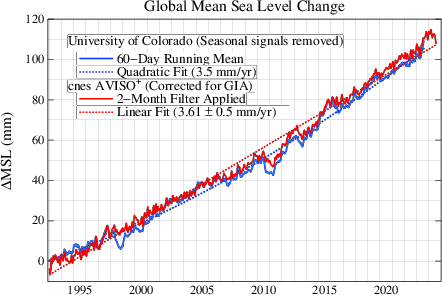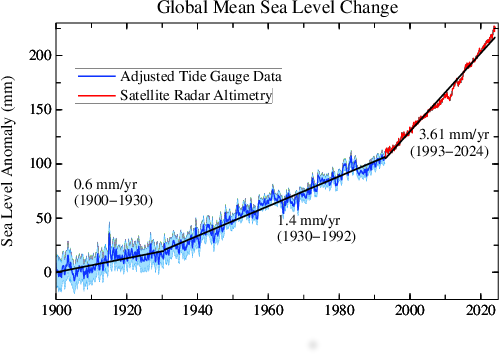
Sea level change is an important climate diagnostic. However, interpretation of the moderate rate of sea level rise of the past century is complicated by the fact that several competing processes contribute to net sea level change. The most important processes are melting of land ice (the large ice sheets on Greenland and Antarctica and mountain glaciers) and thermal expansion of ocean water as the ocean warms. Storage of water behind dams and depletion of groundwater aquifers also affect sea level.
Over the past 5000 years the average rate of sea level rise was much less than 1 meter per millennium (1 mm/year), as shown by geologic markers on coastlines. In the past century tide gauges at coastal cities reveal a larger rate of sea level rise. The second chart below shows that sea level rose about 2 mm/year during 1920-2000.
Satellites began to measure sea level precisely in 1993. Since then sea level has been rising about 3.6 mm/year. This rate is equal to just over one foot per century. The impact of such sea level change is substantial, yet the concern is that far greater sea level rise will occur this century if the major ice sheets disintegrate.
.

Global sea level change measured by TOPEX satellite (1992-2001), Jason-1 (2002-mid 2008), Jason-2 (mid 2008-2015) and Jason-3 (2016-2020). Data source: University of Colorado at Boulder: Sea level change (University of Colorado data through September 7, 2023, and AVISO data through February 6, 2024)
.

Sea level change for 1900-1992, based on tide gauge measurements, from J.A. Church and N.J. White "Sea-level rise from the late 19th to the early 21st Century" Surveys in Geophysics (2011), but multiplied by 0.78 to have 1901-1990 trend as 1.2 mm/yr as stated in C.C. Hay, et al. "Probabilistic reanalysis of twentieth-century sea-level rise", Nature (2015). 1993-2022 data are cnes AVISO. Figure also available in PDF. (Last modified: 2024/04/02)
Greenland and Antarctica have begun to melt faster in the past few years, as shown on Ice Sheet Disintegration page, yet sea level rise slowed slightly in the past few years. The reason seems to be that ocean heat storage decreased in the past five years reducing thermal expansion. Reduced heat storage may be related in part to solar minimum radiation. Ocean heat uptake will surely resume, so acceleration of sea level rise in the next few years may occur. We will discuss the interconnections of climate forcings, global temperature, ocean heat storage, ice melt, and sea level in a paper now in preparation.
Nerem, R. S., D. Chambers, C. Choe, and G. T. Mitchum. "Estimating Mean Sea Level Change from the TOPEX and Jason Altimeter Missions." Marine Geodesy 33, no. 1 supp 1 (2010): 435.
Nerem, R. S., B. D. Beckley, J. T. Fasullo, B. Hamlington, D. Masters, and G. T. Mitchum. "Climate-changedriven accelerated sea-level rise detected in the altimeter era" PNAS (2018). 1717312115.